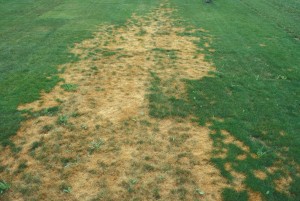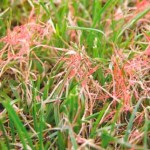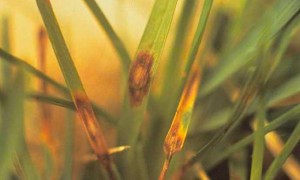 Let’s face it. Summer is tough on lawns. You have grubs, chinch bugs, sod webworms, crabgrass, nutsedge, drought stress, and one of the worst problems, turf disease.
Let’s face it. Summer is tough on lawns. You have grubs, chinch bugs, sod webworms, crabgrass, nutsedge, drought stress, and one of the worst problems, turf disease.
Even with a beautiful, green lawn free of insects and weeds, turf disease can sneak up to destroy all of your hard work.
Most people don’t know what’s happening to their lawn. They assume it’s just summer stress and think it will just green up again when fall rolls around the corner. In some cases, they may be right. However, if you have fungi destroying your lawn, it may NOT come back.

There are quite a few turf diseases that can affect lawns in our area. Diagnosis can be difficult. The first key is to know what type of grass you have in your lawn. Specific diseases will grow on specific host plants, so knowing your lawn will guide you to the right diagnosis possibilities. Turf disease will occur when the disease triangle is present. If the host plant and the pathogen are there, and you can’t control the weather, you’ll get it to some degree.
If you really do your research and ask the right questions, you can figure out which specific disease you have, and what the treatment recommendations are. Preventive fungicide applications on lawns are costly. As a result, most lawn programs do not include these treatments as a default. These materials work fairly well, but only prevent for approximately 3-4 weeks, warranting 3-4 applications during the summer months.
However, if you’re fussy about your lawn, you may want to consider applying preventive fungicides so you don’t see any damage. Otherwise, you’ll just spend the money renovating your lawn in the fall.
If you are at the point where you have already spotted damage, there may also be fungicide recommendations to inhibit further damage. If you don’t feel comfortable with your diagnosis, consult with a local lawn care company that can diagnose the disease, and make application recommendations.
No matter your skill level, you can use look for these 5 things to tell if you have turf disease in your lawn.
 1. Fungal Structures: They vary in shape, color, and appearance, but most turf fungi will have some sort of structure that can be seen when moisture is present. As the nighttime dew settles, you’ll be able to see these strange growths and structures in your lawn.
1. Fungal Structures: They vary in shape, color, and appearance, but most turf fungi will have some sort of structure that can be seen when moisture is present. As the nighttime dew settles, you’ll be able to see these strange growths and structures in your lawn.
2. Matted or Collapsed Areas: Certain diseases will cause grass plants to wilt quickly. This, along with fungal structures, can leave the grass appearing matted or collapsed in some areas.
3. Discolored or Oily Areas: Lawns will often contain multiple species and even cultivars of that species of turfgrasses. This means that some areas will show disease symptoms more than others. Unaffected turf may remain in its typical state when nearby areas may vary in color as the leaf tissue is damaged. In some instances, certain diseases may actually create a darker hue on the grass.
 4. Spots or Lesions on Leaves: Another key to identifying specific turf diseases is noticing the specific damage pattern on the leaf blades of the grass plants. Some spots may vary in color, size, and placement on the leaf tissue.
4. Spots or Lesions on Leaves: Another key to identifying specific turf diseases is noticing the specific damage pattern on the leaf blades of the grass plants. Some spots may vary in color, size, and placement on the leaf tissue.
5. Residue on Shoes and Mower: Depending what fungi is present in the lawn, you may notice strange powdery substances on shoes or on your mower. These will vary in color as well as in time of the year it is present.
Hopefully these 5 things will help you to identify what disease is occurring on your lawn. Treatment recommendations will widely vary based on the specific disease on your lawn, so proper identification is crucial. Find out what’s going on with your lawn before it’s too late!
Leaf Spot courtesy of Penn State University Plant Sciences

